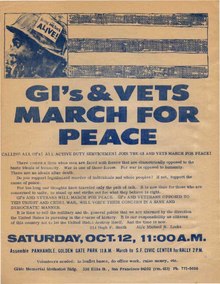
Opposition to United States involvement in the Vietnam War began with demonstrations in 1965 against the escalating role of the United States in the Vietnam War and grew into a broad social movement over the ensuing several years. This movement informed and helped shape the vigorous and polarizing debate, primarily in the United States, during the second half of the 1960s and early 1970s on how to end the Vietnam War.

Sir! No Sir! is a 2005 documentary by Displaced Films about the anti-war movement within the ranks of the United States Armed Forces during the Vietnam War. The film was produced, directed, and written by David Zeiger. The film had a theatrical run in 80 cities throughout the U.S. and Canada in 2006, and was broadcast worldwide on Sundance Channel, Discovery Channel, BBC, ARTE France, ABC Australia, SBC Spain, ZDF Germany, YLE Finland, RT, and several others.

The Fort Hood Three were three United States Army soldiers – Private First Class James Johnson, Private David A. Samas, and Private Dennis Mora – who refused to be deployed to fight in the Vietnam War on June 30, 1966. This was the first public refusal of orders to Vietnam, and one of the earliest acts of resistance to the war from within the U.S. military. Their refusal was widely publicized and became a cause célèbre within the growing antiwar movement. They filed a federal suit against Secretary of Defense Robert S. McNamara and Secretary of the Army Stanley Resor to prevent their shipment to Southeast Asia and were court-martialed by the Army for insubordination.

The Concerned Officers Movement (COM) was an organization of mainly junior officers formed within the U.S. military in the early 1970s. Though its principal purpose was opposition to the U.S. involvement in the Vietnam War, it also fought for First Amendment rights within the military. It was initiated in the Washington, D.C. area by commissioned officers who were also Vietnam Veterans, but rapidly expanded throughout all branches and many bases of the U.S. military, ultimately playing an influential role in the opposition to the Vietnam War. At least two of its chapters expanded their ranks to include enlisted personnel (non-officers), in San Diego changing the group's name to Concerned Military, and in Kodiak, Alaska, to Concerned Servicemen's Movement.

GI's Against Fascism was a small but formative organization formed within the United States Navy during the years of conscription and the Vietnam War. The group developed in mid-1969 out of a number of sailors requesting adequate quarters, but coalesced into a formal organization with a wider agenda: a more generalized opposition to the war and to perceived institutional racism within the U.S. Navy. Although there had been earlier antiwar and GI resistance groups within the U.S. Army during the Vietnam era, GI's Against Fascism was the first such group in the U.S. Navy. The group published an underground newspaper called Duck Power as a means of spreading its views.

The Movement for a Democratic Military (MDM) was an American anti-war, anti-establishment, and military rights organization formed by United States Navy and Marine Corps personnel during the Vietnam War. Formed in California in late 1969 by sailors from Naval Station San Diego in San Diego and Marines from Camp Pendleton Marine Base in Oceanside, it rapidly spread to a number of other cities and bases in California and the Midwest, including the San Francisco Bay Area, Long Beach Naval Station, El Toro Marine Air Station, Fort Ord, Fort Carson, and the Great Lakes Naval Training Center.

GI coffeehouses were coffeehouses set up as part of the anti-war movement during the Vietnam War era as a method of fostering antiwar and anti-military sentiment within the U.S. military. They were mainly organized by civilian antiwar activists, though many GIs participated in establishing them as well. They were created in numerous cities and towns near U.S. military bases throughout the U.S as well as Germany and Japan. Due to the normal high turnover rate of GIs at military bases plus the military's response which often involved transfer, discharge and demotion, not to mention the hostility of the pro-military towns where many coffeehouses were located, most of them were short-lived, but a few survived for several years and "contributed to some of the GI movement's most significant actions". The first GI coffeehouse of the Vietnam era was set up in January 1968 and the last closed in 1974. There have been a few additional coffeehouses created during the U.S. led wars in Iraq and Afghanistan.

The Stop Our Ship (SOS) movement, a component of the overall civilian and GI movements against the Vietnam War, was directed towards and developed on board U.S. Navy ships, particularly aircraft carriers heading to Southeast Asia. It was concentrated on and around major U.S. Naval stations and ships on the West Coast from mid-1970 to the end of the Vietnam War in 1975, and at its height involved tens of thousands of antiwar civilians, military personnel and veterans. It was sparked by the tactical shift of U.S. combat operations in Southeast Asia from the ground to the air. As the ground war stalemated and Army grunts increasingly refused to fight or resisted the war in various other ways, the U.S. “turned increasingly to air bombardment”. By 1972 there were twice as many Seventh Fleet aircraft carriers in the Gulf of Tonkin as previously and the antiwar movement, which was at its height in the U.S. and worldwide, became a significant factor in the Navy. While no ships were actually prevented from returning to war, the campaigns, combined with the broad antiwar and rebellious sentiment of the times, stirred up substantial difficulties for the Navy, including active duty sailors refusing to sail with their ships, circulating petitions and antiwar propaganda on board, disobeying orders, and committing sabotage, as well as persistent civilian antiwar activity in support of dissident sailors. Several ship combat missions were postponed or altered and one ship was delayed by a combination of a civilian blockade and crewmen jumping overboard.

Waging Peace in Vietnam: U.S. Soldiers and Veterans Who Opposed the War is a non-fiction book edited by Ron Carver, David Cortright, and Barbara Doherty. It was published in September 2019 by New Village Press and is distributed by New York University Press. In March 2023 a Vietnamese language edition of the book was launched at the War Remnants Museum in Ho Chi Minh City, Vietnam.

The G.I. movement was the resistance to military involvement in the Vietnam War from active duty soldiers in the United States military. Within the military popular forms of resistance included combat refusals, fragging, and desertion. By the end of the war at least 450 officers were killed in fraggings, or about 250 from 1969–1971, over 300 refused to engage in combat and approximately 50,000 American servicemen deserted. Along with resistance inside the U.S. military, civilians opened up various G.I. coffeehouses near military bases where civilians could meet with soldiers and could discuss and cooperate in the anti-war movement.
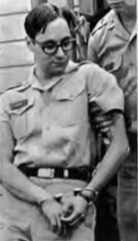
The court-martial of Howard Levy occurred in 1967. Howard Levy was a United States Army doctor who became an early resister to the Vietnam War. In 1967, he was court-martialed at Fort Jackson, South Carolina, for refusing an order to train Green Beret medics on their way to Vietnam. He said it "became clear to me that the Army [was using medics] to 'win hearts and minds' in Vietnamese villages - while still burning them to the ground in search-and-destroy missions." He considered the Special Forces "killers of peasants and murderers of women and children".
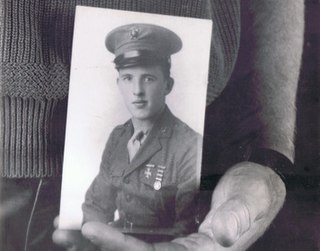
A Matter of Conscience: GI Resistance During the Vietnam War is an artist book published in 1992 at the time of the Addison Gallery of American Art exhibition, “A Matter of Conscience” and “Vietnam Revisited.” It contains oral histories of Vietnam era GIs, gathered and edited by Willa Seidenberg and William Short, and 58 photographs by William Short. Each oral history is complemented by a portrait in which the Vietnam veteran holds an object of some significance such as a newspaper clipping, a legal document, a book, or photograph. The large black and white photographs allow readers to see the veteran while reading the brief but moving oral histories to learn why they turned against the Vietnam War. The veterans' stories and portraits were collected over a five-year period and have been exhibited throughout the United States, Vietnam, Japan and Australia. A number of them were also included in the book Waging Peace in Vietnam: U.S. Soldiers and Veterans Who Opposed the War edited by Ron Carver, David Cortright, and Barbara Doherty. It was published in September 2019 by New Village Press.

The Intrepid Four were a group of United States Navy deserters who grew to oppose what they called "the American aggression in Vietnam" and publicly deserted from the USS Intrepid in October 1967 as it docked in Japan during the Vietnam War. They were among the first American troops whose desertion was publicly announced during the war and the first within the U.S. Navy. The fact that it was a group, and not just an individual, made it more newsworthy.
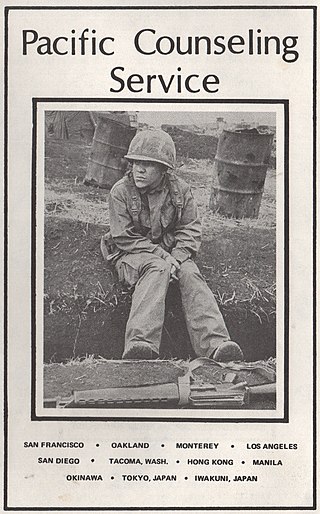
The Pacific Counseling Service (PCS) was a G.I. counseling service organization created by antiwar activists during the Vietnam War. PCS saw itself as trying to make the U.S. Armed Forces "adhere more closely to regulations concerning conscientious objector discharges and G.I. rights." The Armed Forces Journal, on the other hand, said PCS was involved in "antimilitary activities", including "legal help and incitement to dissident GIs." PCS evolved out of a small GI Help office started by a freshly discharged Air Force Sergeant in San Francisco, California in January 1969. The idea rapidly caught on among antiwar forces and within a year PCS had offices in Monterey, Oakland, and San Diego in California, plus Tacoma, Washington. By 1971 it had spread around the Pacific with additional offices in Los Angeles, Hong Kong, Okinawa, the Philippines, as well as Tokyo and Iwakuni in Japan. Each location was established near a major U.S. military base. At its peak, PCS was counseling hundreds of disgruntled soldiers a week, helping many with legal advice, conscientious objector discharges and more. As the war wound down, ending in 1975, the offices closed with the remaining office in San Francisco printing its last underground newspaper in 1976.
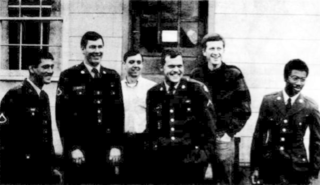
The Fort Lewis Six were six U.S. Army enlisted men at the Fort Lewis Army base in the Seattle and Tacoma, Washington area who in June 1970 refused orders to the Vietnam War and were then courts-martialed. They had all applied for conscientious objector status and been turned down by the Pentagon. The Army then ordered them to report for assignment to Vietnam, which they all refused. The Army responded by charging them with "willful disobedience" which carried a maximum penalty of five years at hard labor. The six soldiers were Private First Class Manuel Perez, a Cuban refugee; Private First Class Paul A. Forest, a British citizen from Liverpool; Specialist 4 Carl M. Dix Jr. from Baltimore; Private James B. Allen from Goldsboro, North Carolina; Private First Class Lawrence Galgano from Brooklyn, New York; and Private First Class Jeffrey C. Griffith from Vaughn, Washington. According to the local GI underground newspaper at Fort Lewis, this was the largest mass refusal of direct orders to Vietnam at the base up to that point in the war. Their refusal and subsequent treatment by the Army received national press coverage.

The GI Underground Press was an underground press movement that emerged among the United States military during the Vietnam War. These were newspapers and newsletters produced without official military approval or acceptance; often furtively distributed under the eyes of "the brass". They were overwhelmingly antiwar and most were anti-military, which tended to infuriate the military command and often resulted in swift retaliation and punishment. Mainly written by rank-and-file active duty or recently discharged GIs, AWOLs and deserters, these publications were intended for their peers and spoke the language and aired the complaints of their audience. They became an integral and powerful element of the larger antiwar, radical and revolutionary movements during those years. This is a history largely ignored and even hidden in the retelling of the U.S. military's role in the Vietnam War.
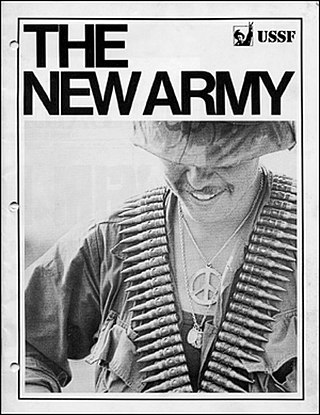
The United States Servicemen's Fund (USSF) was a support organization for soldier and sailor resistance to the Vietnam War and the U.S. military that was founded in late 1968 and continued through 1973. It was an "umbrella agency" that funded GI underground newspapers and GI Coffeehouses, as well as providing logistical support for the GI antiwar movement ranging from antiwar films and speakers to legal assistance and staff. USSF described itself as supporting a GI defined movement "to work for an end to the Viet Nam war" and "to eradicate the indoctrination and oppression that they see so clearly every day."

On June 5, 1969, during the height of the Vietnam War and the soldier and sailor resistance to it, 250 men rioted in the military stockade at U.S. Army post Fort Dix located near Trenton, New Jersey. The prisoners called it a rebellion and cited grievances including overcrowding, starvation, beatings, being chained to chairs, forced confessions and participation in an unjust war. One soldier said you can only treat us "like animals for so long", while another described "unbearable circumstances". The Army initially called it a "disturbance" caused by a small number of "instigators" and "troublemakers", but soon charged 38 soldiers with riot and inciting to riot. The antiwar movement, which had been increasingly recognizing and supporting resistance to the war within the military, quickly moved to defend the rebels/rioters and those the Army singled out for punishment. On June 18, the Army announced charges against 38 soldiers for "participating in a riot", "destruction of Government property, arson and conspiracy to riot." Soon the slogan "Free the Fort Dix 38" was heard in antiwar speeches, written about in underground newspapers and leaflets, and demonstrations were planned.

Soldiers in Revolt: GI Resistance During the Vietnam War was the first comprehensive exploration of the disaffection, resistance, rebellion and organized opposition to the Vietnam War within the ranks of the U.S. Armed Forces. It was the first book written by David Cortright, a Vietnam veteran who is currently Professor Emeritus and special adviser for policy studies at the Keough School of Global Affairs and Kroc Institute for International Peace Studies at the University of Notre Dame, and the author, co-author, editor or co-editor of 22 books. Originally published as the war was ending in 1975, it was republished in 2005 with an introduction by the well known progressive historian Howard Zinn. Despite being first published 49 years ago, it remains the definitive history of this often ignored subject. The book argues persuasively, with encyclopedic rigor, the still under appreciated fact that by the early 1970s the U.S. armed forces, particularly its ground forces, were essentially breaking down; experiencing a deep crises of moral, discipline and combat effectiveness. Cortright reveals, for example, that in fiscal year 1972, there were more conscientious objectors than draftees, and precipitous declines in both officer enrollments and non-officer enlistments. He also documents "staggering level[s]" of desertions, increasing nearly 400% in the Army from 1966 to 1971. Perhaps more importantly, Cortright makes a convincing case for this unraveling being both a product and an integral part of the anti-Vietnam War sentiment and movement widespread within U.S. society and worldwide at the time. He documents hundreds of GI antiwar and antimilitary organizations, thousands of individual and group acts of resistance, hundreds of GI underground newspapers, and highlights the role of Black GIs militantly fighting racism and the war. This is where the book stands alone as the first and most systematic study of the antiwar and dissident movements impact and growth within the U.S. armed forces during the Vietnam War. While other books, articles and studies have examined this subject, none have done it as thoroughly and systematically.
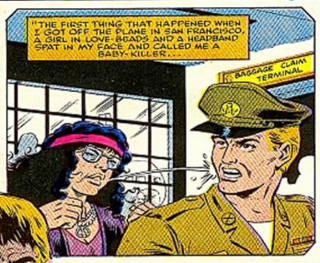
There is a persistent myth or misconception that many Vietnam veterans were spat on and vilified by antiwar protesters during the late 1960s and early 1970s. These stories, which overwhelmingly surfaced many years after the war, usually involve an antiwar female spitting on a veteran, often yelling "baby killer". Most occur in U.S. civilian airports, usually San Francisco International, as GIs returned from the war zone in their uniforms. Perhaps the most well known version of this caricature appeared in 1982 in the first Rambo movie, First Blood, where ex-Green Beret John Rambo, played by Sylvester Stallone, furiously complained about returning "to the world" and seeing "all those maggots at the airport. Protesting me. Spitting. Calling me baby killer". It also appeared in an issue of Marvel Comics GI Joe series in January 1988. But most often now it is used as a talking point by politicians and opinion makers when arguing for the importance of supporting U.S. troops, especially during war time. For example, during the Iraq War, Daniel Henninger, deputy editor of The Wall Street Journal editorial page wrote about the "horrifying" images of GIs being spat on as they returned from Vietnam.

